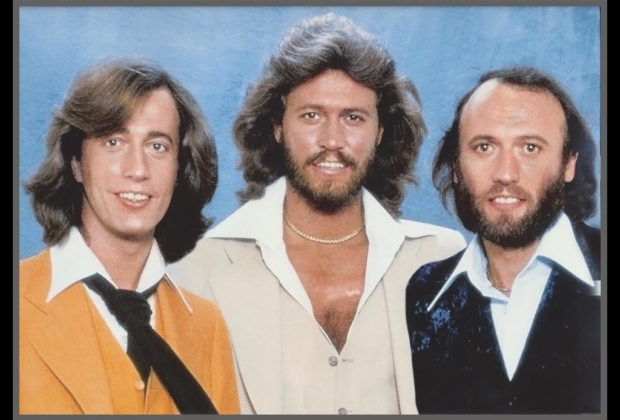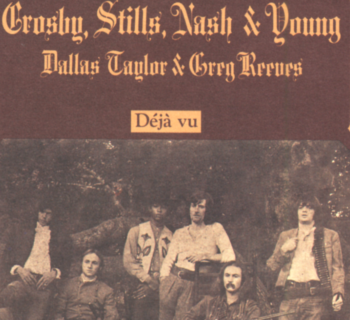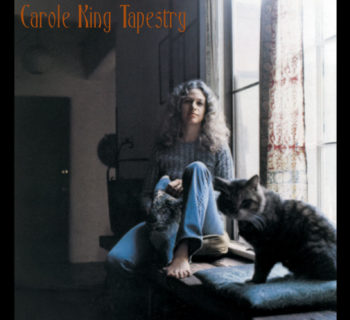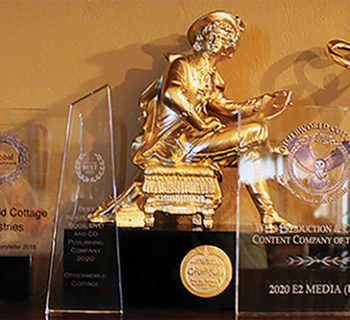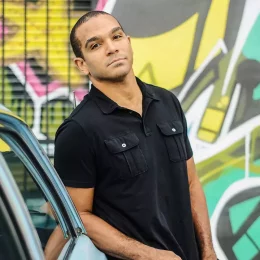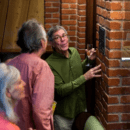The Bee Gees: How Can You Mend a Broken Heart from HBO Documentary Films is a feature length documentary that chronicles the triumphs and hurdles of brothers Barry, Maurice, and Robin Gibb, otherwise known as the Bee Gees.
The iconic trio, who found early fame in the 1960s, went on to write over 1,000 songs and have 20 No. 1 hits throughout their career, transcending more than five decades of changing tastes and styles.
“The Bee Gees having recorded 22 studio albums and for numerous soundtracks, including the monumentally successful Saturday Night Fever, the Bee Gees infused popular culture with dozens of worldwide hit singles that featured their singular and highly influential three-part harmonies. They achieved nine Number Ones and 23 Top 10 singles on the Billboard Hot 100 chart, including “How Deep Is Your Love,” “Night Fever,” and “Stayin’ Alive” from Saturday Night Fever, and graced charts around the world with many other classics, including “How Can You Mend A Broken Heart,” “I Started A Joke,” “Lonely Days,” “Words,” and “You Win Again.”
Debut broadcast of The Bee Gees: How Can You Mend a Broken Heart is December 12th on HBO, and will also be streamed on HBO Max.
A media statement from HBO described this new documentary.
“Directed by acclaimed filmmaker Frank Marshall (The Curious Case of Benjamin Button, Seabiscuit) with award-winning producers Nigel Sinclair and Jeanne Elfant Festa (HBO’s The Apollo and HBO’s George Harrison: Living in the Material World), the film is an intimate exploration of the Gibb story, featuring revealing interviews with oldest brother Barry and archival interviews with the late twin brothers Robin and Maurice.
“The film features a wealth of never- before-seen archival footage of recording sessions, concert performances, TV appearances and home videos, as well as interviews with musicians Eric Clapton, Noel Gallagher, Nick Jonas, Chris Martin, Justin Timberlake, music producer Mark Ronson, singer Lulu, and record company executive Bill Oakes, among others.
“The Bee Gees: How Can You Mend a Broken Heart is directed by Frank Marshall; produced by Nigel Sinclair, Jeanne Elfant Festa, Mark Monroe, Frank Marshall; executive produced by David Blackman, Jody Gerson, Steve Barnett, Nicholas Ferrall, Cassidy Hartmann, Ryan Suffern; written by Mark Monroe with story consultant, Cassidy Hartmann.”
In 2018 the UMe record label released Timeless: The All-Time Greatest Hits, the career-spanning collection of top hits by one of music’s most legendary and acclaimed groups features 21 tracks personally selected by Bee Gees co-founder Barry Gibb.
Sequenced in chronological order, Timeless spans decades of Bee Gees smash hits, from their first Australian chart-topper, 1966’s “Spicks and Specks” to “How Deep Is Your Love,” “Night Fever,” and “Stayin’ Alive” from Saturday Night Fever to 1987’s UK Number One single “You Win Again.”
“There is a spirituality about this album and these songs always meant the most to us,” stressed Barry Gibb in his written introduction for Timeless: The All-Time Greatest Hits. “Although there are many other songs, these songs, I feel, are the songs that Maurice, Robin, and I would be most proud of.”
The group has been inducted into the Rock and Roll Hall of Fame, the Songwriters Hall of Fame, BMI Icons, the Vocal Group Hall of Fame, and the Dance Music Hall of Fame. All three brothers were appointed Commanders in the Order of the British Empire in 2001.
“I can never ignore or underestimate the Bee Gees – their singles/hits from late 60s to mid ‘70s were all memorable and still are,” emphasized Melbourne, Australia-based writer, Michael Macdonald in an email.
“Have soft spots for ‘How Can You Mend a Broken Heart,’ ‘New York Mining Disaster 1941,’ ‘Massachusetts’ and ‘Nights On Broadway.’ Can’t forget ‘To Love Somebody’ was written specifically for Otis Redding and Percy Sledge covered ‘I’ve Gotta Get A Message to You.’
“Before the Bee Gees big hits Barry Gibb was already writing great pop songs. Melbourne’s Ronnie Burns had hits here with two Gibb compositions ‘Coal Man’ and ‘Exit Stage Right.’ As you well know, he carried the form over into the ‘70s when the lesser talented Andy Gibb scored hit records and former Melbourne cabaret singer Samantha Sang hit the top with ‘Emotion.’
“Main Course was the transitory LP – abandoning the lush pop of earlier hits for disco/white R&B grooves. Obviously a good career move because the soundtrack to Saturday Night Fever followed. Sad that both Robin and Maurice died young.
“On some levels, you could say the Bee Gees were our Beatles,” underlined Macdonald.
“I see the Bee Gees in the tradition of the great songwriting teams of the 20th century–Goffin/King, Lennon/McCartney, Fagen/Becker,” suggested writer and author Daniel Weizmann via an email.
“Had they merely been a singing group, an ‘Aussie boy band that went disco’ as they’re sometimes portrayed with scorn, then half of Western civilization wouldn’t know at least three Bee Gees songs by heart. They wrote as they sang, with gusto, subtext, heart, and surprise. And when they cast a foreigner’s shocked innocent eye on the urban chaos of ’70s NYC, they captured modern times for all time–it was magical.
“Give them vanguard credit, too–when the whole culture seemed to gravitate West, the Bee Gees had the good sense to go East, to Miami, with Arif Mardin, and embrace dance music. Only the deepest respect for the genre could have allowed them to pull it off as they did. Like Teena Marie, (and unlike so many other blue-eyed soulsters) the Bee Gees disco actually made it to the dance floor.
“Not bad for three lads raised on the Isle of Man. In the five years that followed Main Course, it seemed like every other white rock act tried to make a disco record–some more cringe-worthy than others, very few as natural.
“Legend has it that the brothers wrote most of the material for a low-budget movie called Tribal Rights of the Saturday Night, for which they only had the roughest idea of a plotline, in under a week, holed up in the village of Hérouville in France. Can you imagine the task being handed to any other songwriting team? I’m guessing the results would have been disastrous. But because the Bee Gees had the spirit of dance music, of hustle, of the New York Times effect on man, deep in their blood, they brought the whole operation to life.
‘‘Sometimes super fame has this embalming effect. Like Elizabeth Taylor and Michael Jackson, the very real artistry gets lost in the shuffle, the phenomenon takes over. But the Bee Gees continued to write unforgettable hooky, moving songs. It’s no wonder so many idiots hated them. They were that good.”
“Any list of the greatest groups in music history has to include the Bee Gees: their harmonies, the sheer quality and quantity of their songs,” enthused David Leaf, adjunct professor, UCLA Herb Alpert School of Music.
“Robin and Barry’s lead vocals, their recorded legacy. I’ve been a fan since 1967 and so fortunate to have worked with them writing their authorized biography, creating the retrospective packages for the Grammy tribute to the group and, probably best of all, being entrusted to tell their story in the feature documentary, This Is Where I Came In.
I spoke with Leaf in 2020 for my book Docs That Rock, Music That Matters and asked him about the authorized biography he did on the Bee Gees and this documentary he made on the group This Is Where I Came In.
“When my Brian Wilson biography, The Beach Boys and The California Myth, was still in galleys, Jay Levy, an executive at RSO Records (the Bee Gees label then), read it because they were looking for somebody to write the authorized biography of the Bee Gees. I think this was in the spring of 1978.
“I got the job and flew to Miami that summer to begin work on it. I spent time interviewing all three Bee Gees, their wives, Robert Stigwood, Andy Gibb and their parents, wrote the book and it came out in 1979. Was my best-selling book by far. Throughout the rest of the century, I worked with the Bee Gees on various projects, including, perhaps most significantly, their Rock and Roll Hall of Fame induction.
“When I started to make all sorts of music docs and retrospectives in the 1990s, it was a natural for me to want to make one on the Bee Gees. I knew from the work I’d done with them that I had earned a measure of trust that is essential in every documentary. I think their then-manager Carol Peters might have brought the idea up originally and fortunately, A&E’s Biography series thought this was a great subject for a two-hour special. The timing was right. The Bee Gees were about to release what ‘insiders’ felt would probably be their last album, if not forever then for a long time. And the title of the album, This Is Where I Came In, was a good name for a career-spanning documentary as well.
“But, very simply, This Is Where I Came In works because the Bee Gees have one of the great family sagas in music history, one of the most-beloved bodies of work ever assembled and also have incredible on-camera presence and a way with an anecdote. You would have to be incompetent to make a bad Bee Gees biography, but I’ll immodestly say that it is a very good one.
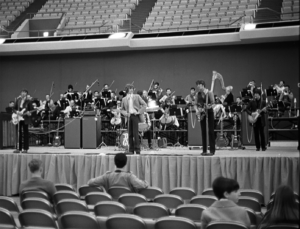
BeeGees at Anaheim Convention Center 1968
Photo by Henry Diltz
“It’s great that the film has won so many admirers, and love that those who weren’t particularly big Bee Gees fans who watched it, said, ‘I couldn’t turn it off.’ And then they told me that they had much more respect and admiration for the group than before. That means a lot to me because one of my goals is that in creating these films of artists who I passionately care about appeal not just to their hard-core fans but even more importantly, make new fans for them too.
“For this film,” concluded Leaf, “I had the advantage of my decades-long relationships with the Gibbs. And the brothers were competitive too; they wanted to get screen time. And the way to do that is offer a terrific insight or relate a very cool anecdote. That’s unusual. Also really key is if that if your subject believes you will protect them in the editing room, they will be even more revealing in the interview.”
“My older cousin Marilyn, never ever considered the hippest kid in our family, for some reason gifted me with the latest Bee Gees LP for Christmastime 1968," reports down to earth Gary Gibb Gold. "And although it often came a distant third competing with Electric Ladyland and that White album on the livingroom hi-fi console as '68 became '69, the myriad of treasures, musical and especially vocal, which that long-playing ideal Idea revealed over weeks, months, and fully years of close scrutiny to come keeps it one of my absolute favorites of the trio's to this very day.
"Sure, I'd been already well aware of various Bee Gee Top 40 smashes piping out my six transistors up to that point – up to and certainly including Robin's latest tour-de-force 'I Started A Joke,' right there on Idea vinyl Side 2.
“But between scaling Kilburn Towers, imagining what Indian Gin and especially Whisky Dry must do, threatening to join the Air Force but gathering instead thousands of golden daffodils for my very own classroom Kitty girlpals I slowly but surely was becoming aware of subtle yet creeping qualities of the Gibbs' compositional craft. Too easily distracted, floated as we all were second-by-stereophonic-second upon the brothers' wholly Everly and even Wilson-calibre genetic vocal pool, it's essential to remember Barry, Maurice and Robin forever considered themselves instead SONGWRITERS first, and performers (a distant?) second. And whilst certainly hinted at more often than naught across their previous albums, on Idea this key gift began blossoming towards hitherto unimaginable realms; fully noteworthy songcraft which served each Gibb extremely well throughout the remainder of their rare and precious career.
"Now I'll happily admit to spending so much time over the past half century gathering up, listening to, and learning so much from the Bee Gees' clutch of styles, dozens of albums, and literal hundreds of songs. But I'll always remember it was Cousin Marilyn's thoughtful Idea of '68 where I first came in, sending me down this most rewarding of all sonic paths. And I'll continue to go anywhere with them."
In the January 21, 1978 issue of Melody Maker I interviewed the three Bee Gees. The subsequent article was titled How The Bee Gees Captured America. I saw the group in the late sixties and over the entire seventies in concert and at several Midnight Special television show tapings in Burbank, California.
At that time I used to get some scorn and ridicule directed at me from punk rock advocates and “Death to Disco” scribes when I proudly announced my loyalty to the Bee Gees.
42 years later I’m now working my catalog and even more delighted re-visiting one of my encounters with the lads.
“One of the reasons for the Bee Gees’ success,” explained Robin Gibb at their rented Benedict Canyon home [while filming the 1977 Michael Schultz-directed Sgt. Pepper’s Lonely Hearts Club Band in Culver City], “is that we’ve ever used music as soap box.
“Music, I’ve always believed, can take you away from reality and you have the option to identify with the music. Something happens when people are bound together through a song.
“Like, ‘How deep is Your Love.’ Personalities are examined in that tune, but female or male aren’t even mentioned. It has universal connotations and it clicks with everyone. Before we cut that song we knew we could fuse some of our own personalities into the track. Love is an anchor, it’s a foundation. Not all our songs are light and breezy. I’ve said it before, but we write our songs. We’re not interpreters. Ten years ago, most music was a social outcry, and we never subscribed to that pattern. We didn’t jump on trends and we’ve seen a lot of them the last decade. Flower power. Glitter… I think the Bee Gees have always realized that there is so much love to bring out in songs that it is a catalyst to bring people together.”
One of the reasons for the Bee Gees’ revival has to be their strong live performances. Their most recent stage show in Southern California (without orchestra) is much more rhythmic and varied.
“Maurice is singing harder parts, falsettos,” offered Barry Gibb. “Before, we played it safe and strict. We used the orchestra as a cushion. It was beautiful, but we weren’t taxing our abilities. When I look back at the days when we toured with 30 pieces, I know we were on display and opposed to communicating with the audience. Going to a bigger band and leaving the orchestra at home was a logical extension. We didn’t want to cling on to something that didn’t make us feel comfortable. I think our stage act improved 100 per cent. The orchestra was beautiful, but restrictive at times.
“I think the kids and younger people want to open up a bit more at concerts. We’re now more self-contained on stage and I really dig working with our band. Looking back, the orchestra did colour many of our songs. But at times we might have overused the strings and some of our work became mushy. Strings are beautiful tools to work with. They can break your heart.”
During my couple of interviews with the Bee Gees, I visited the set of Sgt. Pepper’s and spent part of the afternoon walking around the yellow brick road at the fabled Metro-Goldwyn-Mayer movie studio in Culver City with Barry Gibb and Peter Frampton, who also appeared in the film.
Del Shannon, Kim Fowley, Bobby Womack, George Benson, Helen Reddy, Johnny Rivers, Minnie Riperton, Mark Lindsay, Jack Bruce, Monte Rock III, Al Stewart, John Mayall, Alan White, Jose Feliciano, Tina Turner, Peter Noone, the Paley Brothers, Margaret Whiting, Gwen Verdon and many others appeared in a star-studded finale conducted by George Martin. I spent 10 minutes with Ms. Verdon!
It was the last movie to be made at MGM under the guidance of the studio’s existing management.
A security guard at the Metro-Goldwyn-Mayer main entrance lot gate recognized me from the nearby El Marino elementary school we had attended together in Culver City. He handed me an all access pass and parking permit for a space once reserved for Elvis Presley when he did Speedway.
On his lunch break my childhood playground friend insisted on taking me on a tour inside M-G-M, including the dressing rooms of Judy Garland, Clark Gable and Frank Sinatra. We both marveled at a huge lobby poster of director Alfred Hitchcock’s North by Northwest, stunned by the beauty and sheer elegance of actress Eva Marie-Saint. After viewing that artifact, I somehow managed to continue my next interview session with the Bee Gees.
At the MGM lot, I asked them about their last studio album, Children of the World, which yielded the hit single ‘You Should Be Dancing’. The LP was much harder-sounding than its predecessor, Main Course.
“We wanted an album that was more nervous,” stated Maurice Gibb. “We felt Main Course was a little too varied. There were too many directions.
“We wanted to take the R&B flavour in Main Course a step further with Children of the world. We are always trying to establish a direction. Groups should have guidelines, but also be open for experimentation. When we did Mr. Natural we didn’t have a positive direction. We were thrashing about and some good things came out of that album.”
All three Gibbs were quick to credit Arif Mardin, producer of Mr. Natural and Main Course, for showing them new studio tricks.
“Our studio tactics had become lazy,” admitted Barry. “We had to own up and Jerry Wexler recommended Arif.”
They had some meetings with producers Thom Bell and Richard Perry but nothing came out of these discussions.
“Arif was incredible to work with,” disclosed Robin, “especially with Maurice. He changed our style of recording. We would start with one instrument and build up from there, as opposed to all playing at once. It is a clearer process.”
“Arif was a producer and a referee. He organized sound around a creative base,” Maurice acknowledged.
When the Gibbs recorded Main Course they knew of previous problems and the result was three hit singles. Olivia Newton-John covered “Come On Over,” “Fanny (Be Tender with My Love)” was a huge hit in the U.S. and “Jive Talkin’” was another at the top of the hit parade. “Nights on Broadway” was a top ten smash.
There was charted R&B airplay for “Jive Talkin’” and some compared the Bee Gees to the Average White Band, another Mardin-produced group.
“I can’t believe what a rush we’re all in. Things have never been better,” exclaimed Barry. “We were nervous wrecks at the end of the Sixties: touring, recording, promotion. I was living in Eaton Square and my neighbours must have thought I was a bit freaky. I can remember a time when I walked out of my front door and there were six cars and they all belonged to me. That’s madness,” he confessed.
“I feel very close to my family. We are all living in this house and planning for the future. There was an adjustment period five years ago, but all the little hassles and hang-ups have disappeared. We began to relate to each other as brothers.
“We don’t want to sit on our laurels. We knew we always had a lot more to offer to people than they thought we had. Right now the family is throbbing. No one is looking out for himself and all are looking in.
“We’re working faster and I feel I can write a song in a minute with Maurice and Robin. I’m really happy that people are acknowledging our influence on popular music. You have no idea what a thrill it is to have a top five single in England. With all the new wave and punk rock out I would have thought something like ‘How deep is your love’ wouldn’t have a chance. We always kept going forward and we’re getting stronger every day.”
“We’ve never been inclined to follow other people’s ideas,” reinforced Robin. “If anybody’s gonna follow an idea they’re gonna follow ours. Even though the Beatles influenced a lot of our music, we never aimed to follow what they were doing. We’re still very young as far as I’m concerned and there’s a lot of work around the corner, like films. In a way, we’re just starting.
“We’ve been through all the stages, struggling, and then hitting it big, we’ve split and re-formed, had number ones, toured the world. Of course, we want to continue improving in all areas, but our main concern now is strong albums.”
Robin has changed over the last few years. He appears very confident and far from the insecure figure that toured the U.S. in the last part of the sixties.
“I know what people think of me,” he admits. “I used to be very insecure. There was a lot of pressure around me and I had trouble coping with initial stardom and touring. That’s changed, as I’ve come from this boy-to-man period the last five years. A new era has started. I feel great about the people around me. I know the Bee Gees have touched people. I can see that by our fan mail and questions fans ask when they want me to sign an autograph. The most typical question we receive through the post is ‘When are you visiting again?’”
Harvey Kubernik is the author of 19 books, including Canyon Of Dreams: The Magic And The Music Of Laurel Canyon and Turn Up The Radio! Rock, Pop and Roll In Los Angeles 1956-1972. Sterling/Barnes and Noble in 2018 published Harvey and Kenneth Kubernik’s The Story Of The Band: From Big Pink To The Last Waltz. For summer 2021 the duo has written a multi-narrative book on Jimi Hendrix for the publisher.
Otherworld Cottage Industries in July 2020 published Harvey’s 508-page book, Docs That Rock, Music That Matters, featuring Harvey’s interviews with D.A. Pennebaker, Chris Hegedus, Albert Maysles, Murray Lerner, Morgan Neville, Curtis Hanson, Michael Lindsay-Hogg, Andrew Loog Oldham, Dick Clark, Ray Manzarek, Travis Pike, Allan Arkush, and David Leaf, among others.
In 2020 Harvey served as Consultant on Laurel Canyon: A Place In Time documentary directed by Alison Ellwood which debuted in 2020 on the EPIX/MGM television channel.
Kubernik’s writings are in several book anthologies, most notably The Rolling Stone Book Of The Beats and Drinking With Bukowski.
Harvey penned a back cover endorsement for author Michael Posner’s book on Leonard Cohen that Simon & Schuster, Canada published in October 2020, Leonard Cohen, Untold Stories: The Early Years)

